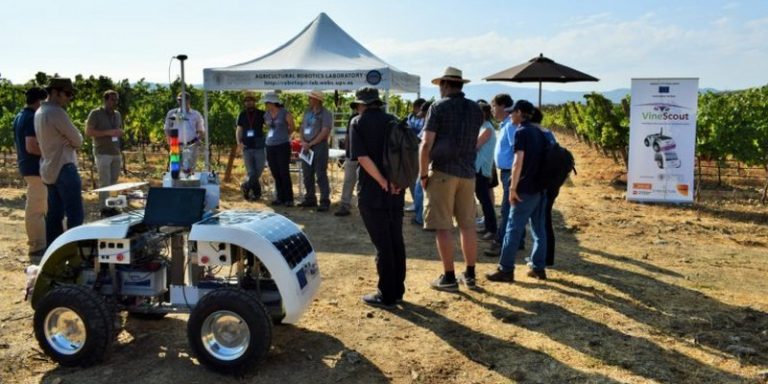
After a French company called on CEA List to develop a machine learning modelto sort corks, it is the turn of the Polytechnic University of Valencia (UPV) to propose an innovative robot in the world of wine growing. This new agricultural machine exploits artificial intelligence, big data and innovations in robotics. This system will help the winegrower to optimize the irrigation of his vines and to plan the harvest more efficiently.
A 100% autonomous vineyard observation robot
For seven years, a team of researchers from the Polytechnic University of Valencia has been working on the development of a vineyard observation robot. Entitled VineScout, it is entirely electric and its battery has a minimum autonomy of two days. In an autonomous way, the device measures the parameters of the vineyard in order to estimate its needs in water, to anticipate the variation of the degree of maturity of the vines or to analyze its vegetative development.
Francisco Rovira, director of the UPV’s Agricultural Robotics Laboratory, spoke of the help this robot would bring to winemakers:
“VineScout can monitor the vineyard as many times as the farmer needs, helping him to make a more rational use of water and, in general, to know the state of the vineyard through objective indicators, such as differences in plant vigour or vine properties within a single plot. It helps the winemaker harvest, fertilize or irrigate more efficiently.”
As soon as the machine is about a metre away from the vines, it collects every piece of data on the ground. The information is tracked using geolocation, so the winemaker knows when and where the measurement was taken. Verónica Saiz, a researcher at the same lab, highlighted the robot’s data capabilities:
“It is capable of recording about 12,000 points per hour, each point contains 30 data. This is much better compared to traditional manual sampling, which barely reaches 40 measurements per hour, which gives an idea of how this robot can facilitate the work of winemakers.”
A system that helps the winemaker, but does not replace him
Francisco Roviva clarifies in his remarks that the robot is there to provide great help to the winemaker, but is not there to perform all the tasks he has to do, in his place:
“With all the data that the robot records and processes, the grower gets a map of his estate, which summarizes the key information needed for advanced crop management. VineScout does not replace the winegrower, it facilitates his work, avoids the hardest tasks in the field and enriches his knowledge and experience, which are now fed with more accurate information in a faster way.”
To avoid loading pre-recorded maps into the robot, the robot incorporates a system that is completely independent of GPS signals. Potential users of the robot are sensitive to this setup, as they are not initiated to this kind of technical manipulation. This model allows VineScout to move through the vineyards autonomously, avoiding collisions and obstacles.
Andres Cuenca, also a researcher in this laboratory, explains how this system works:
“This robot incorporates three perception devices at the front. Two of them allow the system to navigate in a two-dimensional network and do not require the intervention of an operator to drive it when the robot moves between rows. In addition, the safety system makes it stop at any obstacle that may appear in the road, waiting seven seconds for the path to clear or safely stopping the robot and acoustically alerting the operator if it is a permanent obstacle.”
Automating crops and vines
The research team designed the robot with the goal of providing real assistance to farmers in a variety of tasks. Environmental, radiometric and spectral sensors have been installed in the device with this in mind. Francisco Roveira adds:
“VineScout is a completely new approach to agricultural automation for crop trellising that has multiple advantages: it is an autonomous system that can be used in plots where the GNSS signal cannot be guaranteed at all times, it paves the way for the use of megadata in agriculture, it provides critical information on key factors for sustainable agriculture, it allows the integration of other sensors to extend its information capacity and, whatever the demanding environmental conditions, it has proven to be robust and reliable.”
VineScout claims to be the forerunner of crop automation. Indeed, even though this system has been implemented in a ground robot, it could be modified and included in other autonomous machines such as harvesters, weeding machines or grape harvesters with different lenses than data collection. One thing is certain, AI is an increasingly valuable ally in agriculture.
Translated from VineScout : un robot d’observation viticole autonome élaboré par l’Université Polytechnique de Valence









